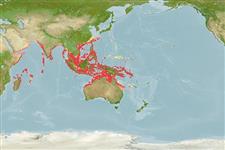Common names from other countries
>
Eupercaria/misc (Various families in series Eupercaria) >
Caesionidae (Fusiliers) > Gymnocaesioninae
Etymology: Dipterygonotus: Greek, di = two + Greek, pteryx = fin + Greek, gono, gone = birth + Greek, noton = back (Ref. 45335).
More on author: Valenciennes.
Environment: milieu / climate zone / depth range / distribution range
นิเวศวิทยา
เกี่ยวกับทะเล,น้ำเค็ม เกี่ยวกับหินโสโครก; ระดับความลึก 37 - 91 m (Ref. 26165). Tropical; 28°N - 24°S, 43°E - 163°E (Ref. 402)
Indo-Pacific: East Africa, not including the Red Sea or Arabian (Persian) Gulf, to the Solomon Islands.
ขนาด / น้ำหนัก / Age
Maturity: Lm ? range ? - ? cm
Max length : 14.0 cm TL เพศผู้/กระเทย; (Ref. 402)
เงี่ยงครีบหลัง (รวม) : 12 - 15; ก้านครีบอ่อนที่หาง (รวม) : 8 - 11; เงี่ยงครีบก้น: 3; ก้านครีบอ่อนที่ก้น: 9 - 11.
Primarily a near-shore pelagic species (Ref. 30573), but swims mainly in open water away from reefs (Ref. 48636). Forms dense aggregations (Ref. 90102). Mixed with other planktivores and is easily overlooked. Feeds on zooplankton (Ref. 30573). Oviparous, with numerous, small pelagic eggs (Ref. 402). Caught at night using lights and dip nets (Ref. 30573). Important tuna bait fish in some countries (Ref. 30573).
Life cycle and mating behavior
Maturities | การสืบพันธุ์ | Spawnings | Egg(s) | Fecundities | ตัวอ่อน
Carpenter, K.E., 1987. Revision of the Indo-Pacific fish family Caesionidae (Lutjanoidea), with descriptions of five new species. Indo-Pac. Fish. (15):56 p. (Ref. 1723)
IUCN Red List Status (Ref. 130435)
CITES (Ref. 128078)
Not Evaluated
Threat to humans
Harmless
Human uses
การประมง: มีการค้าเพียงเล็กน้อย; เหยื่อ: usually
เครื่องมือ
Special reports
Download XML
แหล่งที่มาจากอินเตอร์เน็ต
Estimates based on models
Preferred temperature (Ref.
115969): 23.8 - 28.4, mean 27.4 (based on 421 cells).
Phylogenetic diversity index (Ref.
82804): PD
50 = 1.0000 [Uniqueness, from 0.5 = low to 2.0 = high].
Bayesian length-weight: a=0.01122 (0.00514 - 0.02450), b=3.04 (2.87 - 3.21), in cm Total Length, based on all LWR estimates for this body shape (Ref.
93245).
ระดับชั้นอาหาร (Ref.
69278): 3.4 ±0.45 se; based on food items.
ความสามารถในการกลับคืนสู่ปกติ (Ref.
120179): ความสูง, เวลาต่ำสุดที่จะทำให้ประชากรเพิ่มขึ้นเป็น 2 เท่าใช้เวลาน้อยกว่า 15 เดือน (Preliminary K or Fecundity.).
Fishing Vulnerability (Ref.
59153): Low vulnerability (10 of 100).
